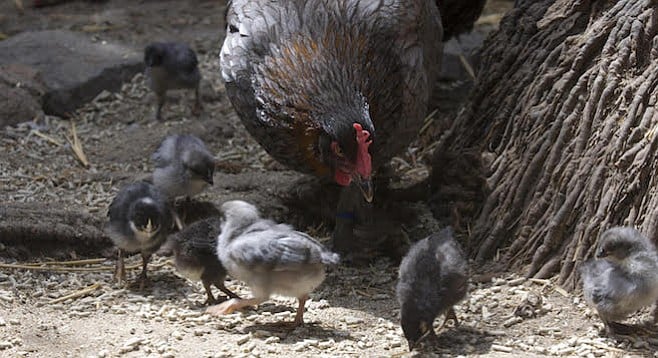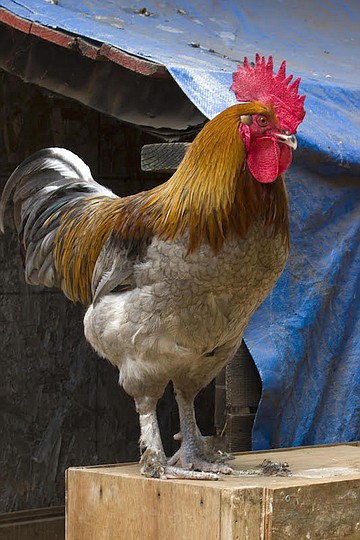 Facebook
Facebook
 X
X
 Instagram
Instagram
 TikTok
TikTok
 Youtube
Youtube

City Heights resident Jen said she is startled by two roosters at four o’clock almost every morning.
“If they wake me up, sometimes it’s hard to fall back asleep,” she said. “I asked for suggestions on dealing with it on [my social media] because I couldn’t find clear answers by Googling [it, but] according to multiple people, chickens are legal within the city — but roosters are not.”
Jen is a 35-year-old marketing director who has lived by Swan Canyon in City Heights since 2013. In the past month she said she’s “had it” with the roosters crowing throughout the day and night.
On August 17, she asked her neighbors for some help.
“Others are bothered, too,” she said, “and if multiple people need to sign a petition — several have reached out to me to volunteer to be a part of the petition.”
Samantha Maguire is a 34-year-old law student who lives about a mile away from Jen, by Orange Avenue and 54th Street.
The “non-stop” crowing for “around nine hours [makes it] difficult to sit on my balcony and carry a conversation when every two minutes [because] a rooster crows again,” she said.
Another nearby resident, Bianca A., said, “I would argue that dogs barking are as loud or louder than quiet roosters. I understand the regulation; however, there is noisy neighborhood construction that far outweighs the rooster crowing — which I find pleasant.”
Another local came forward with a few online answers and remedies that pertain to animal noises.
One was a city link that shows a noise abatement and control municipal code that states both single- and multi-dwelling residential areas have a noise limit of 40 to 60 decibels. Various websites state that roosters’ crows are rated on average at about 90 decibels.
Another link he listed was on the code-enforcement section of the City of San Diego website. It reads: “The keeping or maintenance or the permitting to be kept or maintained upon any premises owned, occupied or controlled by any person of any animal or animals which by any frequent or long-continued noise, shall cause annoyance or discomfort to a reasonable person of normal sensitiveness in the vicinity” is unlawful.
Then there’s another link on the County of San Diego website that states that “no roosters are permitted” but city residents can have 15 to 25 chickens, depending on their property line and how far the chickens are to any building used as a residence.

If a resident wants to phone in a report, they can call City of San Diego code enforcement at 619-236-5500.
Some of the residents said they can’t pinpoint the exact location of the crowers. A neighbor said, “When they do find them and sic the city on the [rooster] owner, the city hits them with a warning first, then comes back after a few days to check if the rooster is still present, and if the rooster is gone — the case gets closed. But what happens is the rooster is stashed somewhere else for the meantime, and when the heat is off the residence, the rooster is returned home.”
But for residents who live in the unincorporated San Diego County, according to Benjamin Cossel, a Casa de Oro resident, “The [homing of rooster] rules are far less restrictive. As people who practice sustainability and food sovereignty, a rooster is a critical component.”
Cossel is the director of the Bancroft Center for Sustainability. His program includes a garden and a teaching site that promotes skills that are helpful “to live in community and to protect our Mother Earth.” His family owns 10 laying hens, 13 chicks and a copper Maran rooster who they named Chauncey.
“My neighbor came over and asked if we could do something about [Chauncey],” he said. “My wife and I had already been investigating ways to mitigate the crow and stumbled upon the ‘no-crow’ crow collar. It’s been a great discovery and literally saved Chauncey’s life. For a rooster to get that good crow we all know, they have to be able to fill their throat with air. The collar inhibits that ability while still allowing the rooster to function in every other way. They’re still able to crow — and he does — but the volume of the crow is greatly diminished.”
Cossel said Chauncey is also the defender of his chicken flock by protecting them against predators — he “allows nature to do its thing and every year or so allowing a clutch of eggs to hatch out (rather than limiting the hens to two to three years). “Hens will lay eggs with or without a rooster,” Cossel explained, “but in order to get a fertilized egg, and thus a chick, you have to have a rooster….
“Incidentally, I had it explained to me by a city representative that the restriction has less to do with the noise factor and more about discouraging cockfighting.”


City Heights resident Jen said she is startled by two roosters at four o’clock almost every morning.
“If they wake me up, sometimes it’s hard to fall back asleep,” she said. “I asked for suggestions on dealing with it on [my social media] because I couldn’t find clear answers by Googling [it, but] according to multiple people, chickens are legal within the city — but roosters are not.”
Jen is a 35-year-old marketing director who has lived by Swan Canyon in City Heights since 2013. In the past month she said she’s “had it” with the roosters crowing throughout the day and night.
On August 17, she asked her neighbors for some help.
“Others are bothered, too,” she said, “and if multiple people need to sign a petition — several have reached out to me to volunteer to be a part of the petition.”
Samantha Maguire is a 34-year-old law student who lives about a mile away from Jen, by Orange Avenue and 54th Street.
The “non-stop” crowing for “around nine hours [makes it] difficult to sit on my balcony and carry a conversation when every two minutes [because] a rooster crows again,” she said.
Another nearby resident, Bianca A., said, “I would argue that dogs barking are as loud or louder than quiet roosters. I understand the regulation; however, there is noisy neighborhood construction that far outweighs the rooster crowing — which I find pleasant.”
Another local came forward with a few online answers and remedies that pertain to animal noises.
One was a city link that shows a noise abatement and control municipal code that states both single- and multi-dwelling residential areas have a noise limit of 40 to 60 decibels. Various websites state that roosters’ crows are rated on average at about 90 decibels.
Another link he listed was on the code-enforcement section of the City of San Diego website. It reads: “The keeping or maintenance or the permitting to be kept or maintained upon any premises owned, occupied or controlled by any person of any animal or animals which by any frequent or long-continued noise, shall cause annoyance or discomfort to a reasonable person of normal sensitiveness in the vicinity” is unlawful.
Then there’s another link on the County of San Diego website that states that “no roosters are permitted” but city residents can have 15 to 25 chickens, depending on their property line and how far the chickens are to any building used as a residence.

If a resident wants to phone in a report, they can call City of San Diego code enforcement at 619-236-5500.
Some of the residents said they can’t pinpoint the exact location of the crowers. A neighbor said, “When they do find them and sic the city on the [rooster] owner, the city hits them with a warning first, then comes back after a few days to check if the rooster is still present, and if the rooster is gone — the case gets closed. But what happens is the rooster is stashed somewhere else for the meantime, and when the heat is off the residence, the rooster is returned home.”
But for residents who live in the unincorporated San Diego County, according to Benjamin Cossel, a Casa de Oro resident, “The [homing of rooster] rules are far less restrictive. As people who practice sustainability and food sovereignty, a rooster is a critical component.”
Cossel is the director of the Bancroft Center for Sustainability. His program includes a garden and a teaching site that promotes skills that are helpful “to live in community and to protect our Mother Earth.” His family owns 10 laying hens, 13 chicks and a copper Maran rooster who they named Chauncey.
“My neighbor came over and asked if we could do something about [Chauncey],” he said. “My wife and I had already been investigating ways to mitigate the crow and stumbled upon the ‘no-crow’ crow collar. It’s been a great discovery and literally saved Chauncey’s life. For a rooster to get that good crow we all know, they have to be able to fill their throat with air. The collar inhibits that ability while still allowing the rooster to function in every other way. They’re still able to crow — and he does — but the volume of the crow is greatly diminished.”
Cossel said Chauncey is also the defender of his chicken flock by protecting them against predators — he “allows nature to do its thing and every year or so allowing a clutch of eggs to hatch out (rather than limiting the hens to two to three years). “Hens will lay eggs with or without a rooster,” Cossel explained, “but in order to get a fertilized egg, and thus a chick, you have to have a rooster….
“Incidentally, I had it explained to me by a city representative that the restriction has less to do with the noise factor and more about discouraging cockfighting.”
Comments